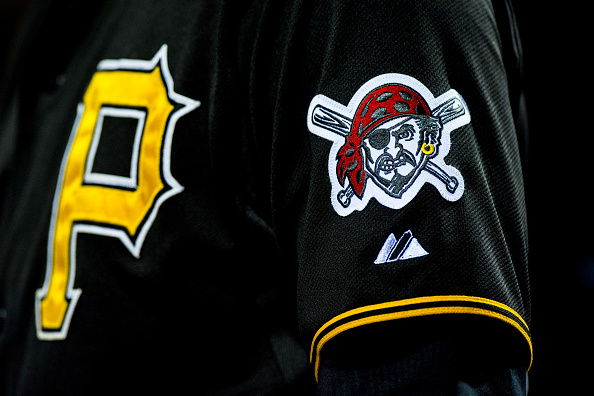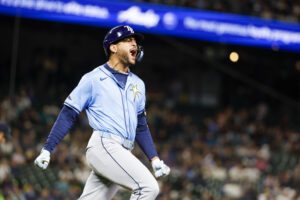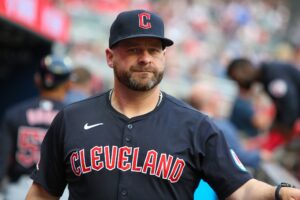With this final installment, we continue to look at the top 10 home runs in Pirates history. The first part began with the number 10 and counted backward to 6. Let’s pick up where we left off.
5. The Captain Comes Through
October 13, 1909, Pittsburgh Pirates 8, Detroit Tigers 4, World Series Game Five at Forbes Field, Pittsburgh. The highly anticipated 1909 World Series was billed as a clash between the Pirates’ Honus Wagner and the Tigers’ Ty Cobb. But it had plenty of star power otherwise. In left fielder/manager Fred Clarke, the Pirates had another future Hall-of-Famer. Clarke and Frank Chance are the only members of the Hall worthy of inclusion as either player or manager. On the Tigers’ side, many historians believe their outfield of Davy Jones, Cobb, and “Wahoo” Sam Crawford to be the greatest in the history of baseball.
In the history of the Series, a seven-game series has been tied after five games 45 times. The team that won game five went on to win the Series 30 times. This series was tied at two games apiece heading into game five. The game was tied 3-3 as the Pirates came to bat in the bottom of the seventh inning. After one-out singles by Bobby Byrne and Tommy Leach, up stepped Clarke, referred to simply as “the captain” in The Pittsburgh Gazette Times. Against Ed Summers, Clarke then lifted the ball, “apparently without great effort,” according to the Times, near the center field wall for a three-run inside-the-park home run. The home run put the Pirates ahead, 6-3, and was the eventual margin of victory. The Pirates went on to win game seven, taking the Series at Bennett Park in Detroit.
Fun fact #1: Clarke invented and held the patent for the flip-down sunglasses, which outfielders still use today.
Fun fact #2: Pittsburgh professional sports teams have won as many championships in Detroit (a World Series, a Super Bowl, and a Stanley Cup) as they’ve won in Pittsburgh (two World Series and an ABA championship).
4. A Sob Story
October 13, 1925, Pirates 3, Washington Nationals 2, World Series Game Six, Forbes Field. In A League of Their Own, Jimmy Dugan tells Evelyn, “There’s no crying in baseball!” Dudley had never heard of Eddie Moore. In game five in Washington’s Griffith Stadium, Pirates second baseman Moore injured his hand diving for a ground ball. Now down in series 3 and 2, the Pirates took the field for infield practice before game six. The first grounder hit Moore’s way and struck his injured hand, the pain collapsing him to the ground. Ten minutes before game time, Wagner, who was there as a spectator, found Moore under the grandstands, sobbing. Moore begged Wagner not to tell manager Bill McKechnie about the injury for fear of being benched.
With the game tied at 2-2, Moore stepped up to lead off the bottom of the fifth. Gripping the bat “with one hand tightly and merely bending his fingers around the handle with the other,” according to the Times, Moore hit a home run into the left field bleachers off Alex Ferguson to put his team ahead, 3-2. The score held up. The Pirates won the Series two days later, coming from behind against Walter Johnson in the late innings. Moore, an unpleasant man, popular neither with his teammates nor the fans, had made his mark in Pirates lore with this home run.
3. Pops Wins It
October 17, 1979, Pirates 4, Baltimore Orioles 1, World Series Game Seven, Memorial Stadium, Baltimore. Willie Stargell, the 39-year-old elder statesman affectionately called “Pops” by his teammates, had a year to remember. He shared the National League MVP Award with Keith Hernandez. Then, he was named the MVP of the NL Championship Series. Why not go for the trifecta and win the World Series MVP Award, too?
After game four, the Pirates looked doomed when the Orioles came back against relief ace Kent Tekulve to take a commanding 3-1 lead in the Series. The Orioles had scored 17 runs in games three and four. It didn’t look like their bats would cool down. Then they forgot how to hit. Or maybe it was the Pirates’ pitching. In any event, Baltimore would score only two runs over the Series’ final three games.
The Orioles were ahead in game seven, 1-0, after five innings. They had to hope their stellar pitching would keep the Pirates down. However, in the top of the sixth, Bill Robinson hit a one-out single past the glove of shortstop Kiko Garcia. Then the left-handed batting Stargell, twirling his bat in his familiar windmill style, crushed lefty Scott McGregor’s first fastball deep to right field and into the Pirates’ bullpen, where the relievers could be seen jumping up and down, arms raised. Stargell’s home run held up, and the Pirates won the World Series for the fifth (and most recent) time.
2. Maz Makes Mantle Cry
October 13, 1960, Pirates 10, New York Yankees 9, World Series Game Seven at Forbes Field. What a crazy World Series that 1960 Series was. The Pirates beat the mighty Yankees in seven games. For the Series, the Yankees outscored the Pirates 55-27. The Yankees won their games by 16-3, 10-0, and 12-0. The Pirates won four close games. It was the only time the Series MVP Award went to a losing team member (Bobby Richardson). Mickey Mantle cried when it was over. It was the only time his teammates had seen him cry. (This post-dated Jimmy Dugan’s declaration.) Casey Stengel was fired for losing the Series.
The game was a back-and-forth affair. The Pirates led 4-0 after two innings. The Yankees led 7-4 after seven-and-a-half innings. After seven, due to a series of wild events (more on that soon), the Pirates led 9-7. Then, the Yankees tied it in the ninth. The Pirates’ leadoff batter in the bottom of the ninth was 24-year-old second baseman Bill Mazeroski, the youngest player on either side. Ralph Terry was on the mound for New York. Terry’s first offering was high. “Maz” turned his hips as if to go for it but let it go by for a ball. Terry’s next pitch was a slider, and Mazeroski didn’t miss it. He hit it over the left field wall as left fielder Yogi Berra looked up helplessly. It remains the only game-seven walk-off homer in World Series history.
It set off the wildest celebration Pittsburgh had ever seen. The victory meant a lot to Pittsburgh sports fans, who had suffered without a professional sports championship for 35 years. To this day, the game’s anniversary is commemorated each year at what remains of the Forbes Field outfield wall.
1. Some People Aren’t Meant to be Heroes
October 13, 1960, Pirates 10, Yankees 9, World Series Game Seven at Forbes Field again. Let’s now visit that crazy eighth inning referred to above. The Yankees led 7-4 after coming back against Pirates relief ace Roy Face. Left-hander Bobby Shantz, on the mound for the Yankees, was beginning his sixth inning of relief. Thus far, he was unscored upon. Gino Cimoli, batting for Face, led off with a single. Bill Virdon followed by rapping a sharp ground ball to shortstop Tony Kubek. It looked to be a sure double play. But the ball took a bad hop and struck Kubek in the throat, sending him to a nearby hospital.
After Dick Groat singled to score Cimoli, Shantz was removed in favor of right-hander Jim Coates. Roberto Clemente stepped up to bat after Bob Skinner’s sacrifice bunt and Rocky Nelson’s short flyout. Clemente hit a bounding ball to the right side of the infield. Coates’s route indicated he was unsure whether to field the ball or cover it first. In the end, he did neither. Virdon scored to cut the lead to 7-6.
Next was Hal Smith, the right-handed half of manager Danny Murtaugh’s catching platoon. The only reason he was in the game was because the starting catcher, Smoky Burgess, had singled in the seventh and was replaced by a pinch runner. Smith nearly swung out of his shoes and whiffed on Coates’s 1-1 pitch. (Asked in 2010 whether he was trying for a home run when a two-out single was more in order, he told me, “I always tried for ‘em!” It was hard to know whether he was serious.)
“An Outdoor Insane Asylum”
On the next pitch, Smith sent it high over the left field wall for a home run to put the Pirates ahead, 9-7. Pandemonium broke loose. Video of the trip around the bases radiates sheer joy. Groat is clapping like a flamenco dancer, Clemente is bounding like a kangaroo, and Smith is nearly running on air. On the radio, Chuck Thompson told his listeners, “Forbes Field at this moment is an outdoor insane asylum!”
So, we already know that the Yankees came back, rendering Smith’s blast an unjustly forgotten footnote. Some people just aren’t destined to be heroes. But compare the circumstances leading up to his home run and Mazeroski’s. Ask yourself, which was more clutch? Which was more dramatic? Smith’s home run put the Pirates in the lead that deserves the top ranking.
Curtain Call
In 2010, a kinescope of Game Seven was discovered among the belongings of Bing Crosby, who was a part owner of the Pirates in 1960. It was premiered at the Benedum Center for the Performing Arts in Pittsburgh. It was also filmed for the MLB Network, with Bob Costas as host. Attendance was by invitation only. On stage were Groat, Virdon, and a gracious Richardson (Mazeroski couldn’t make it), as many former members of the 1960 Pirates were in the front row as could attend. Other attendees included Franco Harris, Michael Keaton, and yours truly.
As the game played, the audience reacted to the events as though they didn’t know what would happen. There was applause every time Clemente was on the screen, even to field a routine single to right. After Smith’s dramatic homer, the audience rose and gave Smith a loud standing ovation. Smith, then 80 years old, struggled to his feet, turned as he gripped his seat, and waved to the people. It had to be the only time in baseball history that a player gave a curtain call in a movie theater for a home run he’d hit 50 years ago.
Main Photo Credits: Gavin Baker/Icon Sportswire/Corbis/Icon Sportswire via Getty Images)






